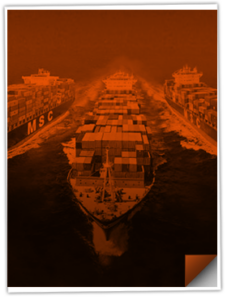Featured Headlines:
Spiral of the Damned: Rates Circle the Drain Before Halloween
The Art of the Self-Inflicted Fee
Tariff Timber: Section 232 Chops into Wood Imports
AGOA Is A-Goin’-Away…And More Tariffs A-Comin’
One Last Piece of Regulatory BIS-ness
Shutdown Shuffle: Will CBP Keep the Beat?
Air Cargo: Six Months of Climb, But Turbulence Ahead
Domestic Tracks: Rail Mergers, Tunnels, and Turf Wars
Spiral of the Damned: Rates Circle the Drain Before Halloween
- Rates Keep Swirling Down the Freight Whirlpool
- The container market has been sucked into a watery vortex — fifteen straight weeks of decline and counting.
- To be sure this wasn’t a ghostly glitch, we checked three trusted tombstones: the SCFI, CCFI, and Drewry’s WCI — all sank together by 8-10% in a WEEK!
- That’s not a trend line anymore. That’s a drain.
- Every Trade Lane is Possessed (and Not in a Good Way)
- Since Sept. 15, every measurable lane from China has gone glub-glub-glub — including you, Manzanillo, and yes, you too, Mombasa.
- Shanghai–LA: down 11% in a week.
- Shanghai–NY and Base Port Europe: both down 7%.
- Shanghai–Dubai and Santos: down 15% — vanishing faster than candy at a haunted house party.
- No lane is safe. The ghosts of blank sailings are back and hungry for blood!
- SCFI Falls to the Abyss — Deeper than a Sunken Chest of Gold
- The global SCFI is now near $1,400/FEU, its sharpest weekly dive in nearly a decade AND the lowest raw number since 2019.
- For perspective:
- Q2’s $1,800/FEU was already 37% below last year.
- Q3 sits at least 40% below Q3 2024.
- Transpacific trades have taken the biggest hits:
- West Coast: -31% YoY
- East Coast: -23% YoY
- We’re now back to pre–Red Sea diversion lows — the era when carriers were already bleeding red ink like extras in a maritime slasher film. How many maritime slasher films are there??!!
- Seasonal Softness? More Like a Halloween Curse
- As industry sage Lars Jensen warned, this isn’t your unusual autumn chill — it’s a market that got weak before Golden Week even started. Intelligent readers, do NOT mix sage into your lattes… wait for Thanksgiving’s stuffing!
- Carriers Try to Resurrect Rates (Cue the Zombie-Vampire Music)
- Insert EVERY GRI notice from EVERY ocean carrier in October (and likely November). No, EVERY single one!
- Will it stick? About as well as an oar sticks to a whirlpool… or a ship maintains its course in a… well, a whirlpool… how many metaphors can one forwarder craft?
- This freight market has officially crossed from “correction” to cursed shipwreck.
- Grab your pumpkin spice coffee and your life vest — because this whirlpool’s got no bottom.
The Art of the Self-Inflicted Fee
- Act I: Tariffs Afloat – Washington’s Newest Wave of Genius
- U.S. Customs has begun charging fees on Chinese-built and operated ships entering American ports — a move meant to “revive” U.S. shipbuilding, though the industry itself is now mostly a memory.
- There’s no clear mechanism to funnel the collected fees into any shipyard, but there’s already a clear outcome: higher costs on everything that floats toward U.S. shelves.
- Beijing fired back with its own port fees on U.S.-linked ships, then slyly exempted those that were built in China — a deft geopolitical wink.
- Analysts note that when ocean carriers absorb fees, they pass those costs down the chain; the bill ultimately lands with American shippers, retailers, and consumers.
- In short, Washington taxes the water, Beijing taxes back, and the U.S. public pays for the tide going out.
- Act II: Green with Fury – The State Department Declares War on Decarbonization
- Not content with taxing trade, the U.S. now threatens to punish countries that vote “yes” on the International Maritime Organization’s Net Zero Framework.
- Proposed measures include new port fees, blocked entry, visa restrictions for crews, and sanctions on officials supporting “activist” climate policy.
- The logic? If other nations try to clean up shipping, America will dirty up trade in response.
- It’s the diplomatic equivalent of scolding your neighbors for installing solar panels — and then charging yourself extra for electricity.
- These penalties wouldn’t make the planet cooler; they’d only make U.S. supply chains hotter under the collar.
- Bottom Line: A Masterclass in Self-Sabotage
- Both initiatives share one genius feature: the illusion that “foreign countries will pay.”
- In reality, ocean carriers adjust rates, shippers absorb surcharges, and American consumers foot the final invoice.
- The result is a new American art form — the self-inflicted fee — in which we bravely tax ourselves for the privilege of blaming someone else.
Tariff Timber: Section 232 Chops into Wood Imports
- On September 29, 2025, President Trump issued a proclamation under Section 232 imposing new tariffs on wood products, effective October 14, 2025. Key measures include:
- 10% global tariff on softwood lumber;
- 25% global tariff on certain upholstered furniture, rising to 30% on January 1, 2026; and
- 25% global tariff on kitchen cabinets and vanities, rising to 50% on January 1, 2026.
- Tariff provisions under Chapter 44 of the USHTS are being removed from Annex II of Executive Order (EO) 14257 for shipments arriving on or after October 14. With no in-transit exclusion, lumber products previously excluded from Annex II will now be subject to reciprocal tariffs unless specifically carved out (get it?) in this EO.
- Not all U.S. trade partners face the same duty cuts:
- The UK is capped at 10%;
- The EU and Japan are capped at 15% combined MFN + 232; and
- Other countries could face reciprocal tariffs unless they secure preferential treatment.
- Commerce’s Section 232 report found that rising wood imports threaten U.S. national security by weakening domestic mills, eroding competitiveness, and risking shortages for defense and infrastructure. Lumber and wood products were highlighted as critical inputs for housing, transport, power grids, and even missile-defense systems.
- The proclamation also warns of possible additional tariffs to prevent circumvention. Countries in active negotiations with the U.S. may be able to secure exemptions or alternatives.
- The action covers all tariff subheadings listed in the proclamation—see the Lumber and Timber 232 Annex for the complete scope.
- Don’t let shifting tariff policy catch you off guard. Sign up for Shapiro’s Shap Flash alerts for real-time trade updates, or bookmark our Trump’s Trade Tariff Updates page to keep your strategy rooted in the latest developments.
AGOA Is A-Goin’-Away…And More Tariffs A-Comin’
- After 25 years of tariff breaks, the African Growth and Opportunity Act (AGOA) has officially expired as of September 30, 2025. Translation? No more duty-free golden ticket for over 30 African countries shipping goods to the United States.
- Sectors that once thrived under AGOA—like textiles, citrus, autos, and vanilla—now face the cold reality of full U.S. tariffs. For U.S. importers, that means higher landed costs, squeezed margins, and a sourcing puzzle that just got a whole lot harder.
- In Africa, governments and exporters are scrambling to soften the blow through bilateral deals, sector-specific carve-outs, and transition measures. At the same time, many are leaning into regional trade under the African Continental Free Trade Area (AfCFTA) or diversifying toward China, India, and the EU.
- For the U.S., the Commerce angle is clear: AGOA’s end creates leverage to renegotiate trade deals on new terms, potentially offering fresh—but narrower—pathways for select partners.
- For importers, this isn’t just a policy change, it’s a wake-up call to rethink sourcing, review contracts, and expect both higher costs and longer lead times until the dust settles.
- Bottom line: AGOA’s curtain call may feel like déjà vu in tariff land, but importers don’t have to go it alone. Shapiro is here to help you navigate new duty exposures, explore alternative origins, and adjust supply chain strategies before your costs splinter. Reach us at [email protected] for support.
One Last Piece of Regulatory BIS-ness
- On September 29, 2025, the Department of Commerce’s Bureau of Industry and Security (BIS) issued an interim final rule (IFR) introducing a new 50% ownership rule.
- Under this rule, any entity that is at least 50% owned by one or more companies on the BIS Entity List or the Military End-User (MEU) List (Supplement No. 7 to Part 744) will now be subject to the same restrictions as the listed company.
- This brings BIS into alignment with the Office of Foreign Assets Control (OFAC), which implemented its own 50% ownership rule earlier. Exporters face the same challenge: tracing complex ownership structures to uncover hidden ties to restricted entities.
- BIS emphasizes that exporters, re-exporters, and transferors now have an affirmative responsibility to determine ownership of the companies involved in their transactions. Even significant minority ownership by an Entity List or MEU-listed company is a red flag requiring heightened due diligence.
- The IFR is intended to close loopholes where restricted companies could otherwise route business through unlisted subsidiaries, while also reducing BIS’s administrative burden of maintaining extensive affiliate lists.
- To meet these requirements, companies may need to dig deeper into ownership data and may consider using compliance software tools already available in the private sector.
- The IFR also includes a Savings Clause: shipments that lost eligibility for license exceptions as a result of this action, but were already en route on September 29, 2025, may proceed under previous rules if delivered by October 29, 2025.
- BIS has invited the public to comment on the 50% ownership rule within 30 days of its publication in the Federal Register (September 30, 2025). Click here to read the full ruling.
- This isn’t just another compliance box to check—it’s a structural shift that makes “Know Your Customer” more important than ever. If you need help untangling ownership webs or setting up a compliance process that won’t crack under scrutiny, Shapiro’s trade experts are here to guide you.
Shutdown Shuffle: Will CBP Keep the Beat?
- It’s official. The government is shut down. What happens to our imports?
- Ports, rails, and 3PLs are STILL on watch—but CBP says core passenger processing and cargo inspections will continue, with approximately 63,000-68,000 personnel retained.
- Coast Guard stays operational. Surface Transportation Board plans to post status guidance. Railroads say trains will roll—private funding = business as usual.
- Ports are signaling “steady as she goes.” LA/LB expects minimal impact to cargo ops and will stay synced with CBP. NY/NJ and Seattle say facilities remain open; Port of Virginia the same.
- Bonded warehouses are a question mark. Utilization has surged amid tariff turbulence; any staffing pinch around paperwork could ripple into holds.
- History lesson from the 35-day shutdown between 2018-19: CBP ran, but lower staffing slowed inspections; LA/LB saw 15–20% longer dwell. Regulated goods (perishables/pharma) faced documentation-driven delays; CBO pegged a ~$8B GDP dent in Q1 2019.
- Net of it: essential keeps moving, but friction builds at the edges—docs queues, PGA touchpoints, and exam timing.
Air Cargo: Six Months of Climb, But Turbulence Ahead
- Sixth straight gain: IATA says August airfreight demand rose 4.1% YoY, the sixth consecutive monthly increase. Load factors ticked up to 44.2%, showing resilience despite global trade and tariff headwinds.
- Sea-to-air switcheroo: Shippers are moving high-value cargo by air to dodge U.S. tariff risk. That’s fueling strong gains on Europe–Asia, Africa–Asia, Middle East–Asia, and intra-Asia lanes, even as Asia–North America traffic slips.
- Regional winners: Africa +11%, Asia Pacific +9.8%, Europe +3.2%, Middle East +2.7%. North America was the outlier, sliding -2.1%, with capacity down 1%.
- Economic backdrop: Global goods trade was up 5.4% YoY in July; PMI optimism at its highest since June 2024. But new export orders are still slowing, signaling ongoing caution.
- Fuel factor: Jet fuel prices dropped 6.4% YoY in August—the 14th straight monthly decline—helping carriers keep costs in check.
Domestic Tracks: Rail Mergers, Tunnels, and Turf Wars
- CSX Hits the Pressure Caboose — All Aboard the Merger Express
- Activist investor Ancora finally blew the whistle: CEO Joe Hinrichs is off the train, replaced by Steve Angel—the same deal engineer who fused Praxair and Linde into one industrial gas giant.
- Wall Street’s timetable is clear: Angel’s ticket to ride is stamped “M&A.” CSX is now free to court a partner as the industry braces for the $85 billion Union Pacific + Norfolk Southern super-merger.
- Choices are slimmer than a dining car menu at midnight. BNSF says “thanks, but we’re freight-lancers,” CPKC already devoured KCS, and Canadian National may be too politically “Ottawaful” to touch.
- Translation: CSX may be the belle of a very small ball, waiting for a dance partner that won’t show.
- Baltimore’s Big Dig — Tunnel Vision Turns Two-High
- After 125 years of single-stack headaches, CSX finally opened the Howard Street Tunnel, turning Baltimore’s bottleneck into a double-stack dream.
- The $450 million project—funded by CSX, Maryland, USDOT, and a few tons of taxpayer ballast—could boost throughput by 125,000 loads annually, while the Port of Baltimore preps for 160,000 extra containers.
- Once bridge work wraps by 2026, CSX promises the fastest I-95 intermodal run from Florida to the Northeast—basically Amtrak speed, but with freight and fewer snack carts.
- Bonus: fewer trucks, cleaner air, and more bragging rights for a city that could use a headline not involving bridge collapses.
- BNSF to Shippers: Don’t Let the UP-NS Love Train Derail You
- BNSF is throwing coal on the fire, warning that the UP–NS megamerger could flatten competition, hike rates, and close 300 intermodal lanes faster than you can say “Surface Transportation Board.”
- Their message to shippers: “If you like choice, make some noise.” The lobbying campaign urges customers to flood the STB with protests before the filing window closes (Oct. 29–Jan. 29).
- BNSF’s slogan might as well be “Stop the Train Before It Gains.” UP and NS call it “synergy.” BNSF calls it “service sabotage in slow motion.”
- Expect a long season of railroad wrestling, where every side claims efficiency—and everyone else calls it track fiction.
- Closing Couplet Fortune Cookie:
- Steel wheels turn and tempers flare,
Where mergers roll, beware hot air.
- Steel wheels turn and tempers flare,



